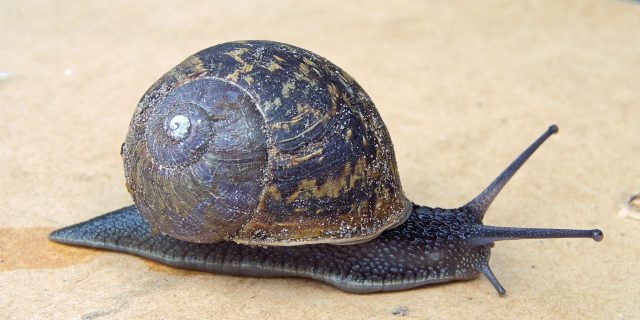25
Aug
Slugs and Snails Controlled with Bread Dough, Really

(Beyond Pesticides, August 25, 2021) Scientists at Oregon State University have found a highly effective bait for slugs and snails: bread dough. Although not quite as exciting as the slug-liquefying nematodes the OSU research team published data on last year, bread dough has the potential to revamp mollusk management, particularly in developing countries where resources are limited. “Bread dough is a nontoxic, generic, and effective tool that could be used in the detection and management of gastropods worldwide,” said study lead author Rory Mc Donnell, PhD. “It represents a tool to aid in managing pest gastropod infestations, either using baited traps or in attract-and-kill approaches. It could also be incorporated into existing baits to improve their attractiveness.”
Critically, bread dough was found to be a more effective bait than commercial attractants like the product Deadline® M-Ps™, which contains the hazardous compound metaldehyde. To test effectiveness, researchers began by making the bread dough using a combination of flour, water and yeast. In a lab setting, slugs were starved for 24 hrs, and then given the option of either bread dough or water (water was used as a control to test if the slugs were simply attracted to humidity). Researchers determined through this trial that slugs were most attracted to bread dough aged between 2 and 8 days.
A similar setup compared the attractiveness of bread dough against Deadline® M-Ps™ using the common garden snail C. aspersum. Of 20 slugs tested, 14 went for the dough, three went for the commercial bait, while three were unresponsive. Field trials were then established to determine real world efficacy. The traps employed, including the Snailer, which allows entry but bars exist, as well as a simple Petri dish, were loaded with bread dough, and a liquid form of metaldehyde was added to the bottom. A control using water and liquid metaldehyde was also used. Slugs and snails overwhelmingly chose to feed on the bread dough baited traps. At one site, on mining reclamation land infested with the land snail X. obvia, researchers were able to trap over 18,000 over the course of two days. Only roughly 850 snails were collected in control bait.
“We gave them a choice of food and they consistently went for the bread dough,” Dr. Mc Donnell said. “They really, really like it. They went bonkers for it. Bread dough outperformed everything.” Although researchers used toxic metaldehyde to kill slugs when they got to the bait, discretely located traps can ensure that a pesticide is not used in a broadcast manner and disposed of properly. However, many traps and baits, such as the Snailer, will work with bread dough and water without the need for additional pesticide, as they bar pests from exiting and cause the slug or snail to drown. Use of metaldehyde should generally be discouraged as the chemical is a suggestive carcinogen, with evidence of neurotoxicity, kidney and liver damage, and reproductive harm. Although the National Organic Program permits the use of the iron phosphate in slug and snail control, its efficacy relies on a synergy between iron phosphate and a so-called “inert” ingredient known as EDTA. In 2014, Beyond Pesticides called on the National Organic Standards Board to delist iron phosphate slug products due to the risks EDTA poses to soil organisms, as well its ability to contaminant soil, sediment and local waterways.
Beyond these concerns lies the fact that current data shows that common commercial slug-control products only kill between 10% to 60% of slugs in a given population. Efficacious biological controls are on the horizon, and have long been registered in Europe, but their cost is often quite high as to be prohibitive for many farmers. Bread dough thus provides a near universally available bait for farmers and gardeners around the globe.
“With worldwide trade and travel, we are getting a homogenization of slugs and snails on planet Earth because of the widespread introduction of species,” Dr. Mc Donnell said. “This is not just a modern phenomenon. Slugs and snails have been traveling with humans for thousands of years. But it’s getting more severe because of purposeful introductions, global trade, intensification of agriculture and development of new crops.”
Managing slugs can be frustrating and often stomach churning. Cultural practices can help get a handle on slug populations, but some form of direct control is often needed. If slugs are suspected of causing crop damage, populations should be regularly monitored using a baiting system. Work to reduce moisture and consider the type of mulch that is being applied. Never water at night, and consider tactics like drip irrigation in particularly damp, slug-prone areas. Hand-picking slugs out of the garden with a disposable glove and placing them into soapy water is one of those stomach-churning activities associated with a slug infestation, but an effective way to reduce populations in a garden. Domestic foul can be helpful at lowering slug populations but need to be closely monitored around growing crops.
See Beyond Pesticides ManageSafe webpage on least toxic control of snails and slugs for more information about how to address these pests without toxic pesticides.
All unattributed positions and opinions in this piece are those of Beyond Pesticides.
Source: Oregon State University, MDPI











This is such great news! I love having a way to remove more slugs from the garden without using toxic chemicals, and I am going to get one of those non-chemical slug traps you mentioned in the article and test it out. Thank you so much!!
August 25th, 2021 at 9:52 pm